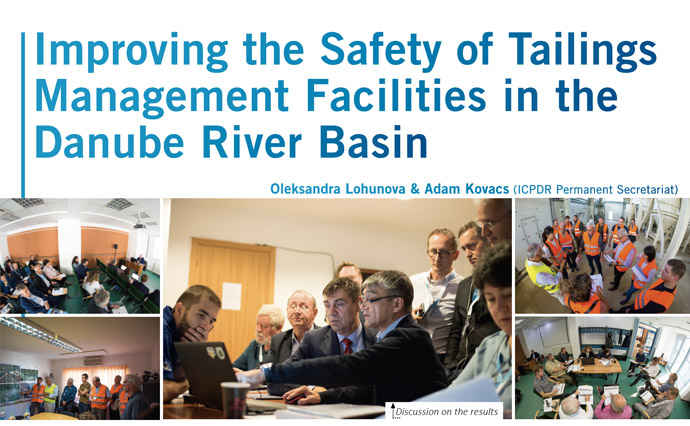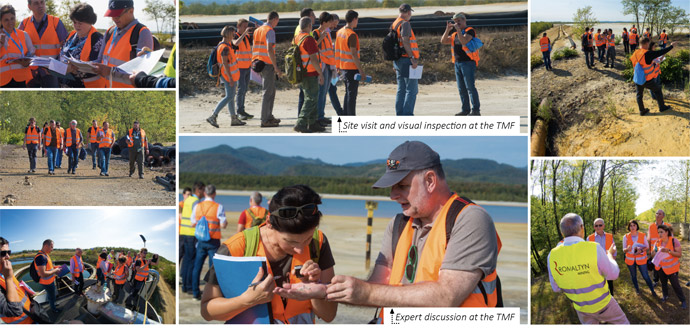Danube Watch 3/2019 - Improving the Safety of Tailings Management Facilities in the Danube River Basin

M ining is one of the most traditional industrial sectors in the world, providing valuable ores and minerals for further processing; it also represents a significant waste stream that is generated by mining operations. One of the components of mining waste is mining tailings that include overburden, waste rock and mine water and are stored and handled in tailings management facilities (TMFs). Due to the physical characteristics and chemical nature of substances that can be found in the tailings, TMFs pose risks to the environment and population. Pollution of water bodies and the related risk or damage to environmental resources often has a negative transboundary effect. Moreover, accidents at TMFs may lead to long-term water and soil pollution and have negative chronic effects on human health.
The surface water bodies of the Danube River Basin (DRB) were severely damaged by several major accident events in the last two decades. The disasters in Baia Mare (2000) and Ajka (2010) dramatically demonstrated what catastrophic consequences the inappropriate operation of industrial and mining TMFs can have on the aquatic environment, population and socio-economic goods. There are a substantial number of TMFs in the basin where adequate safety conditions should be ensured. The Danube countries, under the umbrella of the ICPDR, decided to jointly address these challenges.
Since March 2019, the ICPDR, in cooperation with the Babes-Bolyai University and the non-governmental organisation “Sustainable Development Platform”, has been implementing the project “Capacity development to improve safety conditions of tailings management facilities in the Danube River Basin – Phase I: North-Eastern Danube countries”. The project is funded by the Advisory Assistance Programme of the German Federal Ministry for the Environment, Nature Conservation and Nuclear Safety and supervised by the German Environment Agency. The project aims at narrowing knowledge gaps while raising awareness of TMFs and their hazards in the DRB, ensuring a common set of minimum standards and safety requirements in the DRB is respected while strengthening the technical and management capacity at the concerned facilities and among responsible authorities. The project is accomplishing the following main activities:
- Organising a demonstration regional training event in Romania to deepen the knowledge of invited TMF operators, environmental inspectors and competent authority experts on TMF management.
- Providing recommendations for developing follow-up national training programmes through applying the “train the trainer approach”.
- Improving, completing and promoting a previously developed detailed checklist method based on UNECE “Safety Guidelines and Good Practices for TMFs” to evaluate TMF safety and to recommend measures to improve safety conditions.
- Integrating land use planning aspects into an existing TMF hazard assessment method towards a risk assessment method, taking into account potentially affected populations and water bodies.
Within the project, a regional demonstration training event was organised on 1st-3rd of October, 2019 in Cluj, Romania for invited national TMF operators and environmental inspectors. The training event included theoretical lectures, field exercises at the Baia Mare TMF and desk exercises to introduce, test and amend a detailed checklist methodology. The checklist was developed earlier in a Ukrainian pilot project and it provides a tool to assess the safety conditions of TMFs and to determine what measures should be applied to mitigate accident risk. In total, 24 trainees from Romania, Hungary, Ukraine, the Czech Republic and Serbia (as observer) and 16 trainers, international experts and project partners participated in the training event.

On the first day, a comprehensive programme of lectures was provided to familiarise the participants with the checklist methodology. In addition, a site visit was organised to Baia Mare on the second day to test a specific checklist designed for visual inspection. During the site visit, participants were divided into three groups and each group performed a separate inspection on the facility. The trainees had their own checklist and answered the questions independently. Each group was accompanied by two trainers and a local TMF operator who provided explanations of the questions. Finally, a practical evaluation exercise on the third day completed the training programme. The participants evaluated the overall and categorical safety conditions of the TMF, compared the results of the visual inspections, exchanged their impressions on the site visit and provided recommendations on how to improve the checklist methodology. All the results, training materials and conclusions were placed on the website (www.sendaiplatform.org) which was developed by the project as a platform for knowledge sharing.
Building on the intensive discussions and constructive outcomes of the training event, the project will further revise and improve the entire checklist methodology in order to make it more adaptable for the DRB and to provide a practical tool for operators and inspectors. Moreover, the training event has significantly contributed to the implementation of the “train the trainer approach” set out in the UNECE “Safety Guidelines and Good Practices for TMFs” by educating a number of trainees that will be able to train additional operators and inspectors in their respective countries after the finalisation of the project. The project will provide recommendations for the Danube countries on developing follow-up national training programmes in order to further capitalise on the project's outcomes.
International workshop on the 28th-29th
The outcomes of the project will be demonstrated and discussed at a broader international level at an international workshop to be held on the 28th-29th of April, 2020 in Vienna, Austria. International specialists from the Danube countries, other river basin organisations and the UNECE region will be invited to the workshop. The workshop will further promote project outputs and will demonstrate the project as a good example on transnational cooperation on capacity building for other regions and river basins. For more visit :
The project has elaborated a draft method for TMF risk assessment, building on and extending an existing hazard assessment methodology. This extension is considered to be a key output of the project towards a more comprehensive and adequate assessment tool for TMF risk. Recognising that the existing method does not include any land use planning related aspects or risk assessment parameters, the project will deliver substantial improvement by taking into consideration the risks to human health, the environment and socio-economic goods in relation to TMF accidents. The project made a commitment to integrate these aspects into the hazard assessment by developing the Tailings Risk Index.
A second phase of the capacity building activity is also planned for 2020-2021 for the Sava region with a regional training event in Serbia.






